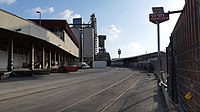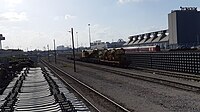Bnei Brak–Ramat HaHayal railway station
Bnei Brak–Ramat HaHayal railway station תחנת הרכבת בני ברק – רמת החייל | |
|---|---|
| Israel Railways | |
 | |
| General information | |
| Location | |
| Coordinates | 32°06′10″N 34°49′52″E / 32.1029°N 34.8310°E |
| Line(s) | Yarkon Railway |
| Platforms | 2 |
| Tracks | 3 |
| Construction | |
| Structure type | At-grade |
| History | |
| Opened | 20 September 1949 |
| Closed | 1990s |
| Rebuilt | 2000 |
| Electrified | 25 December 2021 |
| Previous names | 1949–1954: Tel Aviv haTzafon 1954–2016: Bnei Braq |
| Passengers | |
| 2019 | 1,271,141[1] |
| Rank | 34 out of 68 |
Railways in the Tel Aviv area | |||||||||||||||||||||||||||||||||||||||||||||||||||||||||||||||||||||||||||||||||||||||||||||||||||||||||||||||||||||||||||||||||||||||||||||||||||||||||||||||||||||||||||||||||||||||||||||||||||||||||||||||||||||||||||||||||||||||||||||||||||||||||||||||||||||||||||||||||||||||||||||||||
|---|---|---|---|---|---|---|---|---|---|---|---|---|---|---|---|---|---|---|---|---|---|---|---|---|---|---|---|---|---|---|---|---|---|---|---|---|---|---|---|---|---|---|---|---|---|---|---|---|---|---|---|---|---|---|---|---|---|---|---|---|---|---|---|---|---|---|---|---|---|---|---|---|---|---|---|---|---|---|---|---|---|---|---|---|---|---|---|---|---|---|---|---|---|---|---|---|---|---|---|---|---|---|---|---|---|---|---|---|---|---|---|---|---|---|---|---|---|---|---|---|---|---|---|---|---|---|---|---|---|---|---|---|---|---|---|---|---|---|---|---|---|---|---|---|---|---|---|---|---|---|---|---|---|---|---|---|---|---|---|---|---|---|---|---|---|---|---|---|---|---|---|---|---|---|---|---|---|---|---|---|---|---|---|---|---|---|---|---|---|---|---|---|---|---|---|---|---|---|---|---|---|---|---|---|---|---|---|---|---|---|---|---|---|---|---|---|---|---|---|---|---|---|---|---|---|---|---|---|---|---|---|---|---|---|---|---|---|---|---|---|---|---|---|---|---|---|---|---|---|---|---|---|---|---|---|---|---|---|---|---|---|---|---|---|---|---|---|---|---|---|---|---|---|---|---|---|---|---|---|---|---|---|---|---|---|---|---|---|---|
| |||||||||||||||||||||||||||||||||||||||||||||||||||||||||||||||||||||||||||||||||||||||||||||||||||||||||||||||||||||||||||||||||||||||||||||||||||||||||||||||||||||||||||||||||||||||||||||||||||||||||||||||||||||||||||||||||||||||||||||||||||||||||||||||||||||||||||||||||||||||||||||||||
Herzliya– Ashkelon line | ||||||||||||||||||||||||||||||||||||||||||||||||||||||||||||||||||||||||||||||||||||||||||||||||||||||||||||||||||||||||||||||||||||||||||||||||||||||||||||||||||||||||||||||||||||||||||||||||||||||||
|---|---|---|---|---|---|---|---|---|---|---|---|---|---|---|---|---|---|---|---|---|---|---|---|---|---|---|---|---|---|---|---|---|---|---|---|---|---|---|---|---|---|---|---|---|---|---|---|---|---|---|---|---|---|---|---|---|---|---|---|---|---|---|---|---|---|---|---|---|---|---|---|---|---|---|---|---|---|---|---|---|---|---|---|---|---|---|---|---|---|---|---|---|---|---|---|---|---|---|---|---|---|---|---|---|---|---|---|---|---|---|---|---|---|---|---|---|---|---|---|---|---|---|---|---|---|---|---|---|---|---|---|---|---|---|---|---|---|---|---|---|---|---|---|---|---|---|---|---|---|---|---|---|---|---|---|---|---|---|---|---|---|---|---|---|---|---|---|---|---|---|---|---|---|---|---|---|---|---|---|---|---|---|---|---|---|---|---|---|---|---|---|---|---|---|---|---|---|---|---|---|
| ||||||||||||||||||||||||||||||||||||||||||||||||||||||||||||||||||||||||||||||||||||||||||||||||||||||||||||||||||||||||||||||||||||||||||||||||||||||||||||||||||||||||||||||||||||||||||||||||||||||||
Bnei Brak–Ramat HaHayal railway station is a suburban passenger railway station in Israel, operated by Israel Railways. It is located on the Yarkon Railway near the Bnei Brak–Ramat Gan and Bnei Brak–Tel Aviv borders next to the Ayalon Mall and Ramat Gan Stadium. In spite of its proximity to important industrial and commercial areas of Gush Dan as well as to residential areas of Tel Aviv, Bnei Brak is one of the less-popular stations of Israel Railways, possibly because of its misleading name and lack of awareness. As a result, in an effort to increase the public's awareness of the station, the name of the Ramat HaHayal neighborhood located to the north of the station was added to the station's name in 2016.
The station is located approximately 200 meters from the three-borders point between Bnei Brak, Tel Aviv and Ramat Gan, which is situated near the bridge of Mivtza Kadesh Street over the Yarkon River.
History
Tel Aviv North station

The station was originally opened on September 20, 1949, for the purpose of serving the residents of Tel Aviv, and named Tel Aviv North. At that time, neither the
With the opening of the Coastal railway in May 1953, the Tel Aviv North branch was further lengthened westward to connect with it and the station became more relevant and served as an interim stop on the Haifa–Jerusalem service using the new Coastal Railway. This was enabled since the route through the station could connect to the Jaffa–Jerusalem railway by bypassing central Gush Dan through Tel Aviv North and from there to the Eastern railway via Rosh HaAyin and Lod.
Decline in importance
With the opening of
Resurgence as a suburban rail station
On June 3, 2000, a new suburban service was initiated by Israel Railways, going from Tel Aviv to the
Structure
The passenger station has three platforms—one adjacent to the entrance, and two on an island between two rail tracks.
The station complex also includes a freight terminal and a large rail yard as well as now mostly-disused industrial sidings to warehouses and factories adjacent to the site.
-
Industrial spur to Ramid Siloin Bney Brak rail yard
-
Bney Brak rail yard, the view from the east
Access
Despite its name, Bnei Brak station is close to many northeastern neighborhoods of Tel Aviv, and is the railway station most easily accessible by public transport from Ramat HaSharon. North-East Tel Aviv (Ever HaYarkon neighborhoods) is accessible by frequent bus service operated by Dan Bus Company. The station is also a walking distance from Ramat HaHayal business and leisure zone in Tel Aviv.
The access to the station is from Lehi Street, a
Train service
| Preceding station | Following station | |||
|---|---|---|---|---|
Petah Tikva-Kiryat Aryeh
towards Herzliya |
Herzliya–Ashkelon | Tel Aviv University towards Ashkelon
| ||
Ridership
| Year | Passengers | Rank | Source |
|---|---|---|---|
| 2021 | 282,841 ( |
47 of 66 ( |
2021 Freedom of Information Law Annual Report |
| 2020 | 320,820 ( |
39 of 68 ( |
2020 Freedom of Information Law Annual Report |
| 2019 | 1,271,141 | 34 of 68 | 2019 Freedom of Information Law Annual Report |
References
- ^ "2019 Freedom of Information Law Annual Report" (PDF). Israel Railways.


